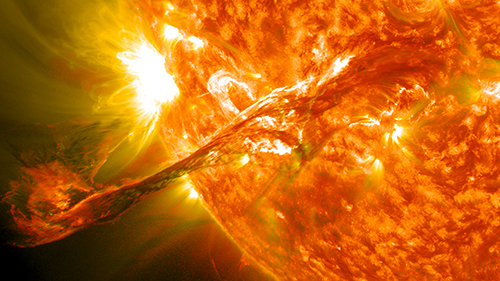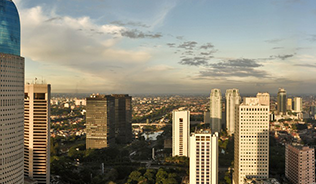Dr Noel Nelson, the current Chair of the IES, is an environmental scientist presently working on the role the atmosphere and the weather plays in transmitting a wide range of animal related diseases. Noel has always had an interest in space and astronomy, and in this blog explores what we know about space weather, the disruption it can cause to us on Earth, and why space weather forecasting is important. If you are interested in finding out more about the areas where environmental and space science overlap, take a look at our recent journal 'Growing in space: Science beyond the biosphere'.
As a budding amateur astronomer in my teens some of the first things I learned about our Sun were that it was an average size star and without it life on our planet would be impossible. We are positioned just at the right distance from our Sun to permit life to flourish. I also learned that the glow we experience from the moon at night was due to the reflected Sun rays and that the Sun could emit a stream of charged particles out into space (solar wind) which, when in collision with our atmosphere, would produce the visual spectacle that is the ‘Northern Lights’ or Aurora Borealis (in the northern hemisphere). However, the life giving properties provided by our Sun do have a ‘sting in the tail’, in the shape of the solar winds and other forms of solar emissions.
Understanding space weather
Temperatures at the Sun’s outer regions may reach up to 2 Million ⁰ F – hot enough to enable rapidly moving particles to pull away from its gravitational effects and head out into space. During an approximate 11 year cycle the quantity of ejected material, radiation levels and number of Sun spots will vary considerably. This variation will affect the properties of the solar wind, such as its magnetic field, velocity, temperature and density.
On occasions, the Sun will release very large bursts of energy across the entire electromagnetic spectrum in the form of flares. These are hard to predict but can be detected in the Earth’s atmosphere some 8.5 minutes after an occurrence. Released at similar times to flares are large amounts of ejected matter carrying its own magnetic field known as coronal mass ejections (CMEs) or ‘solar storms’. These have a stronger impact than the standard solar winds and may take several days to reach the Earth. These emissions and ejections will interact with the Earth’s upper atmosphere and magnetic field to produce a variety of effects. It is the arrival times of such events that form the main focus of ‘space weather forecasts’. Space weather describes the changing environmental conditions in the near-Earth space vicinity. Just as the weather experienced on the Earth describes changes in the atmospheric environment, space weather describes changes in the space environment between the Sun and the Earth.
Hazards and disruption to communications
The ejection of particles in the solar winds is a phenomenon older than the Earth itself, and certainly low level space weather events occur quite regularly. In the main the Earth’s atmosphere has provided protection from the worst elements of this phenomenon. However, our increasing dependence on modern technology has made us more vulnerable to the hazards associated with CME events. In particular, the highly charged particles may interrupt radio communications, operations that rely on Global Navigation Satellite Systems (Global Positioning Systems), as well as power grid systems which may experience a level of disruption. Severe space weather events fortunately only occur once every hundred years or so, but when they do happen the potential for significant disruptions is high, so much so that these events have acquired a high priority on the UK National Risk Register.
Flights involving high latitude polar routes are used every year to enable more cost effective journeys. High Frequency communications are the only way to keep in contact with aircrafts on such routes. A severe space weather event may interrupt the signals causing radio blackouts. Well established protocols are in place to allow aircrafts to mitigate such losses in communications. Those as yet to take off can be re-routed to avoid the worst effects. Both passengers and crew travelling certain routes during a space weather event may be exposed to higher levels of radiation during such events, although the increased risk of cancer is minimal.

This image of a CME erupting from the Sun on 31 August 2012 was taken from the Solar Dynamics Observatory. When it reached the Earth's magnetosphere this CME caused aurora to appear on the night of 3 September 2012. Credit: NASA/GSFC/SDO (Licensed under CC BY 2.0).
The ionosphere is a region in our atmosphere containing gas molecules that have been split (mainly by UV light) leaving behind charged ions and free electrons. This region of the atmosphere provides an important means of long-distance radio communication. High frequency waves may be ‘bounced’ off this region to enable signals to travel well beyond the line of sight. Communications with satellites using Very High Frequency (VHF) and Ultra High Frequency (UFH) waves which pass through the ionosphere are also critical for a range of operations. The interaction of solar flares with the ionosphere causes the absorption of High Frequency (HF) communication signals and can cause blackouts. Similar disruptions may occur during geomagnetic solar flares which can disrupt VHF signals, degrading in particular mobile satellite communications. Because the solar flares travel at the speed of light, forecasting the resulting blackouts is not possible. However, advanced notification of a period of heightened solar activity can help to raise awareness of the potential for disruption.
Geomagnetic storms can cause large variations in the Earth’s magnetic field. This in turn can induce electrical currents in conductors such as power lines or oil and gas pipe lines. The induced current can cause voltage instabilities in power grids and lead to transformer burn outs. Sizeable disturbances of this type have occurred on several occasions in the past, most recently in Quebec, Canada in 1989 and Malmo, Sweden in 2003. During these events, voltage instabilities in the power grid systems resulted in system collapse followed by large areas exposed to power loss for many hours. Energy companies can use space weather forecast services to minimise these impacts and to improve system designs that lead to improved resilience.
Resilience and forecasting
The full extent of our vulnerability to these space weather events has been recognised by many countries and much effort is underway to monitor the Sun’s activities as well as building more resilient systems. In the UK the Met Office has joined forces with the British Geological Survey, Bath University and RAL Space to improve our capability. International collaborative partnerships have also been forged with the US National Oceanic and Atmospheric Administration. Typical space weather forecasts highlight changes in solar activity, solar wind/geomagnetic activity and energetic particles/solar radiation. The focus of forecasts is concentrated on detecting events in a timely fashion that will enable the release of alerts and warnings for solar flares and radiation events.





